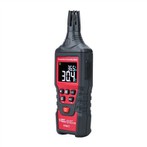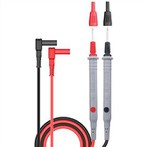12 Dos and Don'ts When Using Clamp Meters
(1) Before using the digital multimeter, read the instruction manual carefully to familiarize yourself with the function of the power switch and the function of the limit switch, input jack, socket, and various function keys, knobs, and accessories. In addition, you should also understand the limit parameters of the multimeter, the characteristics of overload display, polarity display, low voltage display and other symbol display and alarm, and grasp the changing law of the decimal point position. Before measurement, carefully check whether the test lead is cracked, whether the insulation layer of the lead wire is damaged, and whether the position of the test lead is inserted correctly to ensure the safety of the operator.
(2) Before each measurement, check again whether the measurement item and the limit switch are in the correct position, and whether the input jack (or special jack) is selected correctly.
(3) The meter will jump when just measuring, and you should wait for the displayed value to stabilize before reading.
(4) Although the digital multimeter has a relatively complete protection circuit inside, it is still necessary to avoid operational errors, such as using a current block to measure voltage, using an electric block to measure voltage or current, and using a capacitor block to measure charged Capacitors, etc., so as not to damage the meter.
(5) If only the highest digit displays the number "1" and the other digits are blanked, it proves that the meter has been overloaded, and a higher limit should be selected.
(6) It is forbidden to toggle the limit switch when measuring a voltage above 10OV or a current above 0.5A, so as not to generate an arc and burn the contacts of the transfer switch.
(7) The number marked with the danger mark next to the input jack represents the limit value of the input voltage or current of the jack. Once exceeded, it may damage the instrument and even endanger the safety of the operator.
(8) The clamp multimeter is not allowed to measure the current of the high-voltage line, and the voltage of the measured line cannot exceed the voltage level specified by the clamp meter (generally no more than 500 volts), in order to prevent insulation breakdown and personal electric shock.
(9) The measurement should estimate the size of the measured current, select the appropriate range, and do not use small range gears to measure large currents.
(10) Pay attention to turn the range switch to the corresponding AC current gear before measurement, and you cannot use the voltage gear and resistance gear to measure the current.
Remember! Never use resistance gear and current gear to measure voltage, if you are not careful, the meter will be burned.
(11) Only one wire can be clamped for each measurement. When measuring, the wire to be tested should be placed in the center of the jaws to improve the accuracy of the measurement. It is best to level the body of the watch with your hands, and try not to let the wire lean against the jaws and the body of the watch.
(12) After the measurement, the range switch must be turned to the maximum voltage range position, and then the power switch should be turned off. To ensure safe use next time.






